An open head injury is one of the most serious and visible forms of brain trauma. Unlike closed head injuries—where the skull remains intact—an open head injury involves a break in the skull that exposes or penetrates the brain tissue beneath.
- What Is an Open Head Injury?
- Common Causes of Open Head Injury
- How Open Head Injuries Affect the Brain
- Symptoms of an Open Head Injury
- Diagnosis and Imaging
- Emergency Treatment and Surgery
- Rehabilitation After Open Head Injury
- Possible Complications
- Prognosis: What Recovery Looks Like
- Prevention: Reducing the Risk of Penetrating Brain Injury
- The Takeaway
This type of injury can be life-threatening within seconds, often requiring emergency surgery and long-term rehabilitation. But for survivors, understanding what happens, how treatment works, and what recovery might look like offers both clarity and hope amid the chaos.
What Is an Open Head Injury?
An open head injury, sometimes called a penetrating head injury, occurs when an external object breaks through the skull and enters the brain. The damage may be localized—affecting a specific area of tissue—or extend along the object’s path, tearing blood vessels and neural structures in its wake.
The hallmark feature is a direct breach of the protective layers—the scalp, skull, and meninges (the membranes surrounding the brain). This direct exposure dramatically increases the risk of infection, bleeding, and swelling inside the skull.
Common Causes of Open Head Injury
Open head injuries typically result from high-velocity impacts or forceful penetration. Common causes include:
- Gunshot wounds: The leading cause in many regions; bullets can shatter bone and create both entry and exit wounds.
- Sharp or blunt objects: Knives, tools, or debris from accidents may pierce the skull.
- Explosions and shrapnel injuries: Particularly among military personnel and in industrial accidents.
- Severe vehicle collisions or falls: In which fragments of bone or metal penetrate the skull.
Each cause presents unique challenges depending on the object’s speed, size, and trajectory. Even if the damage seems localized, secondary swelling or infection can quickly spread and endanger life.
How Open Head Injuries Affect the Brain
When the skull is breached, the brain loses part of its natural protection. Several types of damage can occur simultaneously:
- Primary injury: The direct mechanical damage from the penetrating object, such as torn tissue and blood vessels.
- Secondary injury: The body’s inflammatory response, swelling, and lack of oxygen that worsen damage in the hours or days that follow.
The combination of these two processes determines both the initial severity and the long-term outcome.
The specific deficits depend on which brain region is affected:
- Frontal lobe: Impulsivity, decision-making problems, and emotional changes
- Temporal lobe: Language, memory, or hearing impairments
- Parietal lobe: Loss of sensation or spatial awareness
- Occipital lobe: Visual disturbances or blindness
- Brainstem: Breathing, heart rate, and consciousness regulation
Because the brain is highly specialized, even a small area of damage can lead to significant functional loss.
Symptoms of an Open Head Injury
Symptoms depend on the location, size, and force of impact but often include both physical and neurological signs.
Physical Signs
- Visible wound or bleeding from the head
- Fragments of bone or foreign objects embedded in the skull
- Clear fluid (cerebrospinal fluid) leaking from the nose or ears
- Swelling and bruising around the wound
- Loss of consciousness or altered awareness
Neurological Symptoms
- Weakness or paralysis
- Seizures
- Difficulty speaking or understanding speech
- Unequal pupils or vision loss
- Loss of balance or coordination
- Confusion, agitation, or coma
Open head injuries are medical emergencies. Anyone suspected of sustaining one requires immediate stabilization and transport to a trauma center.
Diagnosis and Imaging
Emergency physicians and neurosurgeons diagnose open head injuries using a combination of physical examination and imaging studies:
- CT Scan: The fastest and most common tool to detect skull fractures, bleeding, or foreign objects.
- MRI: Provides detailed visualization of soft tissue but is often used later, once the patient is stabilized.
- X-rays: May help locate embedded fragments in or near the skull.
Doctors also assess the patient’s Glasgow Coma Scale (GCS) score to gauge consciousness level, guiding prognosis and treatment urgency.
Emergency Treatment and Surgery
Because open head injuries pose immediate threats to life, treatment focuses on stabilization, infection prevention, and surgical repair.
Initial Management
- Maintain airway, breathing, and circulation.
- Control bleeding with sterile pressure dressings (without pressing into the wound).
- Prevent shock with IV fluids and oxygen.
- Administer broad-spectrum antibiotics to prevent infection.
Surgical Intervention
Most open head injuries require emergency neurosurgery to:
- Remove bone fragments or foreign materials
- Control bleeding and relieve pressure on the brain
- Repair the skull and protective membranes
- Reduce swelling (sometimes with a decompressive craniectomy)
Surgeons may also place drains to control intracranial pressure and clean the wound to prevent infection.
Rehabilitation After Open Head Injury
Once the immediate crisis has passed, recovery shifts to a long-term, multidisciplinary rehabilitation program.
Key Components of Rehab
- Physical therapy: Rebuilds strength, coordination, and mobility.
- Occupational therapy: Helps survivors regain independence with daily activities.
- Speech and language therapy: Restores communication and swallowing skills.
- Cognitive rehabilitation: Re-teaches problem-solving, attention, and memory strategies.
- Neuropsychological care: Addresses mood, behavior, and personality changes.
Recovery timelines vary dramatically. Some survivors regain full function; others experience lifelong deficits requiring support and adaptive technology.
Possible Complications
Because open head injuries disrupt the skull and meninges, several serious complications may follow, even with proper care:
- Infections (meningitis or brain abscesses)
- Seizures (post-traumatic epilepsy)
- Cerebrospinal fluid leaks
- Chronic headaches or dizziness
- Cognitive decline or personality changes
- Permanent neurological deficits
Preventive antibiotics, seizure medication, and long-term follow-up help minimize these risks.
Prognosis: What Recovery Looks Like
Outcomes depend on how much brain tissue was destroyed or compromised.
- Localized injuries (small, low-velocity wounds) may allow partial or near-full recovery.
- High-velocity injuries (such as gunshots) often result in extensive damage, coma, or death.
- Early surgery and intensive rehab significantly improve survival and function.
Survivors often require months or years of rehabilitation, but progress can continue long after the initial injury through neuroplasticity — the brain’s ability to adapt and rewire itself.
Prevention: Reducing the Risk of Penetrating Brain Injury
While not all open head injuries are preventable, risks can be reduced through safety awareness and protective measures:
- Use helmets and face shields in construction, cycling, and contact sports.
- Practice firearm safety and secure weapons properly.
- Follow workplace safety regulations in high-risk environments.
- Promote violence prevention and community education programs.
Every step that reduces high-velocity trauma also reduces the likelihood of open head injury.
The Takeaway
An open head injury is among the most severe and dangerous brain traumas, but survival and recovery are increasingly possible with modern neurosurgery and rehabilitation.
While the wound itself may be visible, the deeper challenge lies in the brain’s long path to healing — one that demands patience, expertise, and hope.
Through prevention, rapid medical care, and continued support, even the most serious injuries can lead to meaningful recovery.







